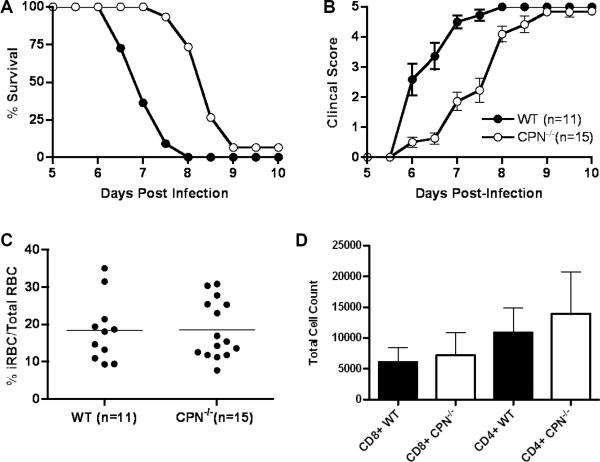Figure 1.
Survival is prolonged and clinical signs of disease are reduced in cerebral malaria in carboxypeptidase N-deficient mice (CPN−/−) compared to wild type mice. Wild type and CPN−/− mice were injected i.p. with 5 × 105 PbA-iRBC and clinical scores and survival were monitored twice daily for ten days as previously described (C5 paper). CPN−/− mice (n=15) were significantly resistant to disease-induced mortality (p=0.0001, Log rank test) compared to wild type mice (n=19) (a) and had reduced disease severity on days 6 through 8.5 (p<0.05, Wilcoxon rank-sum test) (b). The data shown in (a) and (b) are pooled from three independent experiments. The clinical score data shown is the mean and standard error of daily scores within each group of mice. These data indicate that experimental variation was minimal even during disease onset. Parasitemia, assessed at day 6 after infection, was not significantly different between wild type and CPN−/− mice (18.4 vs. 18.6 %iRBCs/total RBC, wild type vs. CPN−/− mice respectively). The data shown are pooled from three independent experiments and the horizontal line indicates the mean value for each group of mice. (c). Brain tissue was isolated from wild type and CPN−/− mice at day 6 (n=4/group) and subjected to flow cytometric analysis as previously described (12). The total number of CD4+ and CD8+ T cells was comparable the brains of CPN−/− and wild type mice (d). The data shown in (d) are the mean and standard error, pooled from three independent experiments. CD4+ T cells: wild type – 10888+/− 4035 vs CPN−/− - 13961+/−6794; CD8+ T cells: wild type – 6087 +/− 2363 vs. CPN−/− - 7197 +/− 3631.

